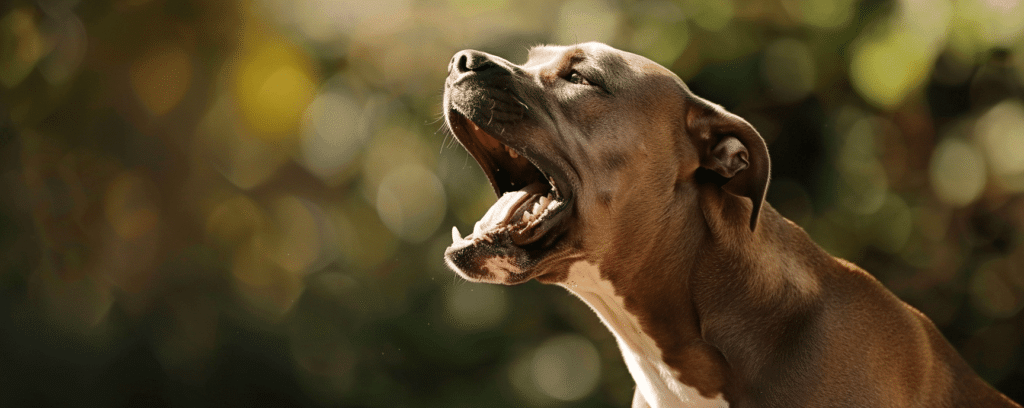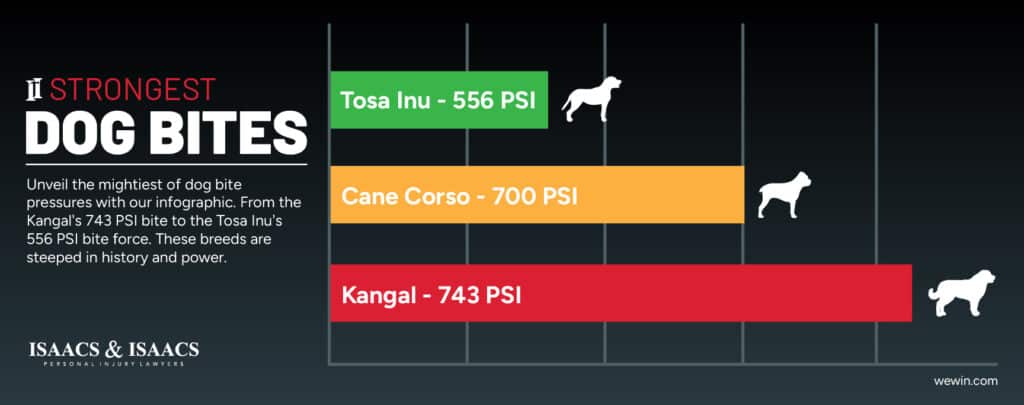Unleashing the Facts: A Comprehensive Dog Bite Force Chart & Analysis
Last updated Thursday, October 17th, 2024

If you’re seeking the cold hard facts about canine jaw power, our dog bite force chart cuts to the chase. We list dog breeds in order of their bite force, measured in PSI, and explain what influences these values. Whether concerned for safety or plain curiosity, our chart provides the direct answers you need, without the fluff.
Key Takeaways
- Dog bite force varies across breeds and is measured in PSI (pounds per square inch), with breeds like the Kangal, Cane Corso, and Rottweiler having some of the strongest recorded bite forces.
- Bite force is influenced by factors beyond breed, including a dog’s skull structure, jaw size, and muscle mass; methods like bite sleeves and mathematical models are used to measure this force.
- While a strong bite force can be associated with aggression, proper training and socialization are key in managing a dog’s behavior, regardless of its biting power, and preventing bite incidents.
Understanding Dog Bite Force
Have you ever wondered why some dogs are considered more dangerous than others, or why specific breeds are chosen as guard dogs or police partners? The answer often lies in their bite force. A dog’s bite force, which can range dramatically across different breeds, is a significant factor in assessing their capability to protect, serve, or potentially cause harm. While a playful nip from a small dog may be harmless, a stronger bite force can lead to serious injuries or even be life-threatening. It’s not just about the size of the dog; the strongest bite force is found in various dog breeds with unique physical characteristics and historical backgrounds. Some dog breeds with strong bite forces include:
- Rottweiler
- German Shepherd
- American Pit Bull Terrier
- Kangal
- Cane Corso
- Dogo Argentino
- Tosa Inu
It is important to note that a dog’s bite force alone does not determine its temperament or behavior. Responsible ownership, proper training, and socialization are crucial in ensuring the safety and well-being of both dogs and humans.
Grasping the concept of this force is fundamental, both for safety measures and to appreciate the vast diversity among our four-legged friends.
What Is PSI?
The term PSI may sound technical, but it’s quite simple. PSI, or pounds per square inch, is the standard unit of measurement that quantifies the pressure exerted over a one-square-inch area. This measure allows us to understand and compare the bite force of various dog breeds.
Consider this, the complete force of a dog’s bite, in pounds, gets distributed throughout the contact area of their teeth. This force then gets converted into PSI. Consequently, a high PSI indicates a powerful bite. This metric is significant as it allows us to objectively gauge a breed’s physical biting power and the potential severity of their bite.
Factors Influencing Bite Force
While PSI provides a standardized measure, the actual bite force of a dog can be influenced by a variety of factors beyond just their breed. For example, dogs that have been bred for protection, such as guard dogs, or those with a history of dog fighting, often have a stronger bite force compared to their more docile counterparts. The architecture of a dog’s skull, including the size and shape, plays a significant role in their bite force capabilities. Other contributing factors include the breed’s size, jaw structure, and temperament, all of which can affect the bite force a dog is able to generate.
Hence, even if an American Bulldog possesses a powerful bite force, it doesn’t imply that it will exhibit aggressive behavior without reason.
Measuring Dog Bite Force
Transitioning from the theoretical to the practical, how exactly do we measure the bite force of these powerful creatures? It turns out, the process is intricate and serves a greater purpose than mere curiosity. Recording bite force is pivotal for progress in veterinary medicine and also contributes to forensic investigations. A variety of devices and techniques, including bite force meters, strain gauges, and even computational modeling, have been developed to accurately capture this data. These methods are not without their challenges, as the unpredictability of a dog’s chewing actions can complicate direct measurements, necessitating a range of approaches to acquire reliable data.
Bite Sleeves
One of the tools utilized in bite force measurement is the bite sleeve. This device is specifically designed to endure the full pressure of a dog’s bite in a controlled setting. It allows researchers to obtain reliable bite force data while ensuring the safety of both the dog and the tester.
The bite sleeve acts as a protective barrier that imitates the resistance and texture of potential prey or an intruder, adding authenticity to the measurements. This method is regularly employed in the training of police dogs and guard dogs, where mastering and controlling the bite force is vital.
Weight and Jaw Size Formulas
Beyond physical testing devices, mathematical models offer another avenue for estimating a dog’s bite force. These models consider the size and shape of a dog’s skull and the mass and architecture of their jaw muscles, which are all critical aspects for generating bite force. By taking into account these physical features, the models provide a more in-depth understanding of a dog’s anatomical capacity to bite with force.
Fascinatingly, values obtained from ‘dry skull’ models, which rely solely on the skull, are frequently lower than those derived from live dogs, mirroring the dynamic aspect of a dog’s bite in real-world scenarios.
Dog Breeds with the Strongest Bite Force
As we delve deeper into the world of canine bite force, let’s take a moment to showcase the breeds that stand out in this category. The dog breeds with the strongest bite force, or dog’s bite force, are a diverse group, with the Kangal leading the pack with an astonishing 743 PSI. These breeds range from the protective Cane Corso to the mighty English Mastiff, each breed exhibiting impressive bite force measurements that reflect their physical capabilities and historical roles.
Whether used in guarding livestock or as great family pets, the bite force of these breeds, including German Shepherds, is a testament to their strength and the evolutionary paths that have shaped them.
Kangal (743 PSI)
At the apex of the chart, the Kangal dog boasts an unparalleled bite force of 743 PSI. This breed, originating from Turkey, is renowned for its role in guarding sheep against formidable predators like wolves and bears. The Kangal’s remarkable bite force is not merely for show; it serves a vital purpose in their protective duties, providing a natural deterrent to any threat that may endanger the flock.
With their impressive strength and vigilant nature, Kangal dogs are the epitome of an excellent guard dog, embodying both the power and responsibility that come with a strong bite force.
Cane Corso (700 PSI)
Not far behind the Kangal is the Cane Corso with a formidable bite force of 700 PSI. This Italian breed has a storied history as a guard dog and a hunter, valued for its strength and courage. The Cane Corso’s bite force is a reflection of its robust nature and its utility in roles that require a dog to be both protective and resilient.
As a breed that combines power with a balanced temperament, the Cane Corso exemplifies the kind of breed that benefits from being well-trained and socialized, especially considering its potential for harm with such a strong bite.
Tosa Inu (556 PSI)
The Tosa Inu, with a bite force of 556 PSI, hails from Japan and has a heritage rooted in dog fighting. This breed’s bite force and build were honed over generations for the silent and stoic demeanor necessary in the fighting ring. While the Tosa Inu today is more commonly a protective and loyal companion, its significant bite force remains a feature of the breed, indicative of its historical purpose and the silent power it holds.
The Tosa Inu, much like other breeds with strong bite forces, demonstrates the importance of understanding a breed’s background when considering their behavior and capabilities.
Analyzing Bite Force and Aggression
While the previous sections have primarily focused on the measurement of bite force, it’s important to analyze the relationship between this physical trait and a dog’s overall aggression. A common misconception is that a dog with a strong bite force is inherently more aggressive, but this is not always the case. Factors such as the dog’s individual personality, upbringing, and training play a significant role in their behavior.
Breeds recognized for their high bite force, such as pit bulls, the Dogo Argentino, a powerful breed of dog, can exhibit docile and friendly traits when suitably socialized and trained from their puppyhood. Dogs might bite out of fear, protection, or even discomfort, instead of an inherent aggression, and this is true for other dogs as well.
Dangerous Breeds with High Bite Force
The term “dangerous breeds” often stirs up images of dogs with menacing jaws and an aggressive demeanor. Breeds such as Rottweilers and Wolfdogs, which possess high bite force measurements, can indeed pose a risk if not handled by experienced owners. Such breeds may require a particular understanding and approach, as their strength combined with any aggressive tendencies can lead to serious consequences.
It is crucial to remember that while certain breeds may have a reputation for aggression, this can often be mitigated or managed with the right training and socialization, preventing their bite force from becoming a liability.
Importance of Training and Socialization
Highlighting the potential hazards linked to a dog’s bite force stresses the significance of training and socialization. These vital aspects of dog ownership aren’t exclusive to breeds with a strong bite force but are applicable to all dogs. Even powerful breeds like Wolfdogs, which may be challenging for novice owners, can be well-adjusted members of the family with the right guidance and handling.
Training and socialization from an early age help ensure that a dog’s natural abilities and instincts do not translate into unwanted aggressive behavior.
Preventing Dog Bites and Legal Implications
The issue of dog bites isn’t merely about comprehending canine behavior and strength, it also involves significant legal consequences. In numerous locations, dog owners bear the responsibility for their pets’ deeds, with some states implementing strict liability laws. Dog owners must be vigilant in preventing bites, not only to protect others but also to avoid potentially serious legal consequences.
Whether it’s through proper training or understanding a breed’s temperament, the onus is on the owner to ensure their dog does not become a danger to others.
Tips for Avoiding Dog Bites
Preventing dog bites starts with responsible ownership and understanding how to interact safely with dogs. Avoiding rough play activities that could lead to overexcitement and potential biting incidents is a good starting point. Teaching children how to behave around dogs, especially around breeds known for their strong bite force, is also crucial for preventing bites.
One must acknowledge that any dog, irrespective of its size or breed, can bite under certain conditions, thus, caution and education are fundamental to prevention.
Legal Consequences and Compensation
For those unfortunate enough to experience a dog bite, there are legal avenues for seeking compensation. Homeowners’ or renters’ insurance policies often cover damages resulting from dog bites, providing a financial safety net for victims. Compensation can be sought for both physical injuries and emotional harms, such as psychological trauma or a newfound fear of dogs.
Prompt action and appropriate legal counsel can significantly boost the prospects of a favorable claim, ensuring that victims aren’t left dealing with the aftermath of a dog bite single-handedly.
Frequently Asked Questions
What is the strongest dog bite force ever recorded?
The Kangal dog has the strongest recorded bite force, measuring at 743 pounds per square inch (PSI).
Can any dog breed have a high bite force, or is it specific to certain breeds?
Yes, certain dog breeds, often those bred for protection or fighting, naturally have higher bite force measurements, but any dog can have a strong bite force.
Is a dog with a high bite force more likely to be aggressive?
No, a dog’s aggression is impacted by multiple factors, such as training and socialization, not just its bite force. Therefore, a high bite force does not necessarily indicate aggression.
How can you prevent dog bites, especially from powerful breeds?
To prevent dog bites, it’s important to be a responsible owner, avoid rough play, and ensure proper training and socialization for your dog from a young age. This will help in preventing potential incidents involving powerful breeds.
What legal options do victims of dog bites have for compensation?
Victims of dog bites can file a personal injury claim and seek compensation from the dog owner’s insurance policy for physical and emotional damages. This can help cover medical expenses and other related costs.












